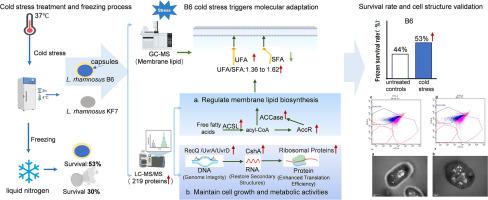低温胁迫通过膜脂重塑和差异蛋白表达增强鼠李糖乳杆菌B6的低温耐受性
IF 5.8
Q1 MICROBIOLOGY
引用次数: 0
摘要
了解乳酸菌低温耐受性的分子机制对于保持其在食品加工中的生存能力至关重要。本研究将不同表型特性的鼠李糖乳杆菌B6和KF7在4℃下预处理2 h,然后进行液氮冷冻。冷应激B6的存活率(53%)显著高于KF7(30%)和未经处理的对照组(44% vs. 10%, p <;0.05),扫描电镜下观察到少量破坏细胞。冷胁迫通过增加不饱和脂肪酸(UFA)和UFA与饱和脂肪酸(UFA/SFA)的比值从1.36增加到1.62来改变B6的膜流动性(p <;0.05)。219种蛋白质,主要涉及脂肪酸生物合成、翻译和运输过程,与未处理的B6相比,在冷胁迫下B6上调。值得注意的是,B6胶囊可能有助于其更高的低温耐受性。我们的研究结果揭示了鼠李糖B6的双重低温耐受性机制,即动态脂质体重塑和协调蛋白表达调节。本研究强调了鼠李糖单株的细胞表面特征和冷胁迫处理在制备益生菌和直接使用深度冷冻法获得高细胞活力的大桶发酵剂中的重要性。本文章由计算机程序翻译,如有差异,请以英文原文为准。

Cold stress enhances cryotolerance in Lacticaseibacillus rhamnosus B6 via membrane lipid remodeling and differential protein expression
Understanding the molecular mechanisms underlying the cryotolerance of lactic acid bacteria is critical for preserving their viability in food processing. In this study, Lacticaseibacillus rhamnosus B6 and KF7 with different phenotypic properties were pretreated at 4 °C for 2 h before liquid nitrogen freezing. Cold-stressed B6 exhibited significantly higher survival (53 %) than KF7 (30 %) and untreated controls (44 % vs. 10 %, p < 0.05), with few disrupted cells observed under SEM. Cold stress altered the membrane fluidity in B6 by increasing unsaturated fatty acids (UFA) and the ratio of UFA to saturated fatty acids (UFA/SFA) from 1.36 to 1.62 (p < 0.05). 219 proteins, primarily those involved in fatty acid biosynthesis, translation and transport processes were up regulated in cold-stressed B6, compared to untreated counterparts. Noteworthy, capsules of B6 likely contributed to its higher cryotolerance. Our findings revealed a dual cryotolerance mechanism in L. rhamnosus B6, i.e., dynamic lipidome remodeling and coordinated protein expression regulation. This study highlighted the importance of the cell surface features of individual strain of L. rhamnosus and cold stress treatment in preparing probiotics as well as direct to vat starter cultures with high cell vitality employing deep freezing process.
求助全文
通过发布文献求助,成功后即可免费获取论文全文。
去求助
来源期刊

Current Research in Microbial Sciences
Immunology and Microbiology-Immunology and Microbiology (miscellaneous)
CiteScore
7.90
自引率
0.00%
发文量
81
审稿时长
66 days
 求助内容:
求助内容: 应助结果提醒方式:
应助结果提醒方式:


